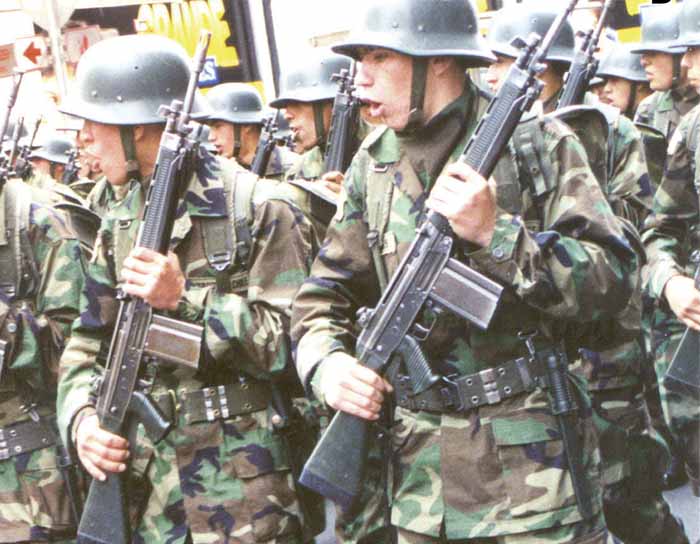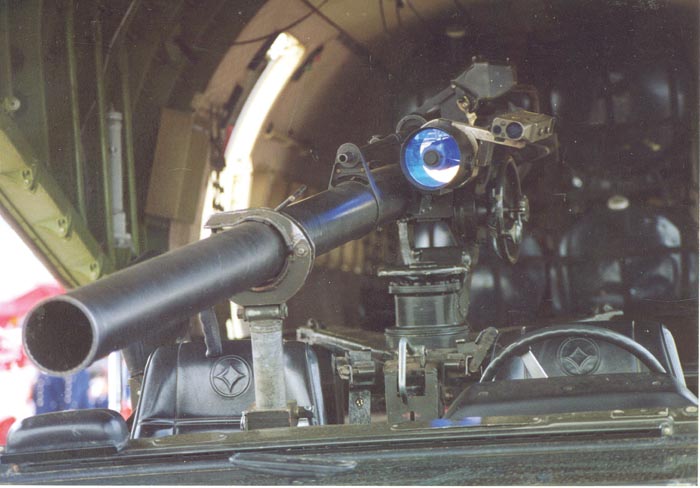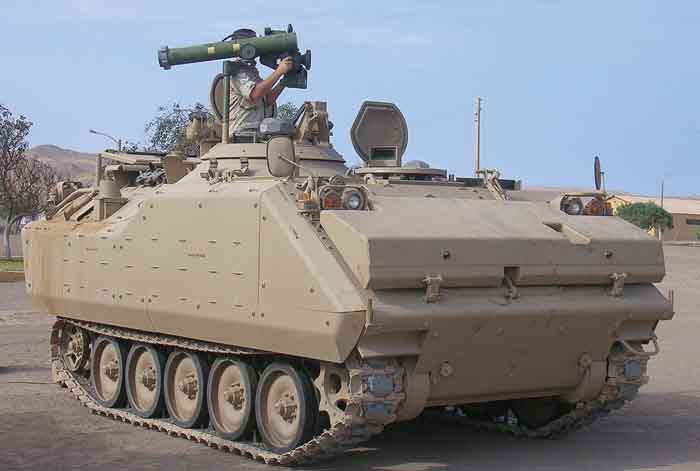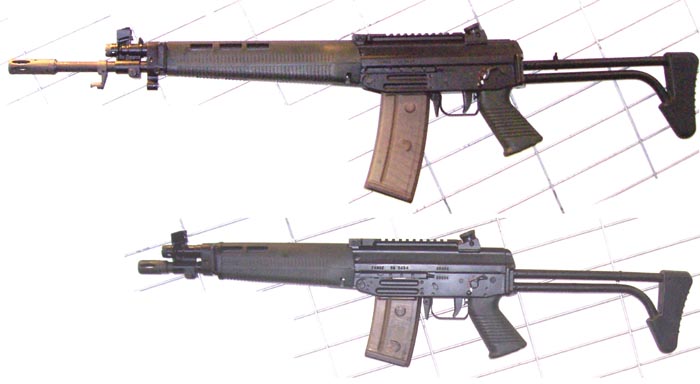By Julio A. Montes

The Chilean Army has been experiencing an overall reorganization assisted by considerable investment in equipment, training and overall modernization. By October 2006, more than 100 new Humvees had arrived with some other 300 expected to be received during 2007. In June 2006, the Communications Regiment Taparaca (R. TELEC. Nº 6) from Iquique received the first YPR-765 IFVs, and the government announced the establishment of the first Armored Brigade at arid Iquique region. All this was in line with a complete material replacement and restructuring around 1 mountain, 2 motorized and 4 armored brigades while preserving its 7 divisions structure. On January 1, 2007 the Army established the Special Operations Brigade (BOE – Brigada de Operaciones Especiales) at Peldehue, which took over the Special Forces Group/Parachute & Special Forces School from La Colina. The new brigade calls Arteaga Fort home, and absorbs the Special Forces Battalion, Parachute Battalion (conventional airborne unit), and the 6th Commando Regiment (desert ops), and will probably oversee the SF School. The new Mountain Brigade most likely will take over for the 1st and 2nd Commando Regiments (Ranger/Commando type units), and the Pathfinder units – mountain troops Yungay (Nº 3), Talca (Nº 16), Los Angeles (Nº 17) and Guardia Vieja (Nº 18).

In addition, Rafael Ltd. from Israel supplied the powerful AT Spike missile and established a maintenance and Operations Center at the National Workshop MMG No.1 Arica (Mantenimiento de Material de Guerra Nº 1). The AT Spike will supplement the M40A1 RCLs, which have been overhauled and modernized with thermal sights, and infrared rangefinder to provide for all weather operations and maximize range. In December 2006, the government acquired a number of Pumar RHIBs from the local ASMAR for operations with the BOE.
The Army is well equipped, and the small arms arsenal includes the Mod 92F pistol, made by Fábricas y Maestranzas del Ejército (FAMAE), and the CZ75 (FN750), also from FAMAE, which has become the standard sidearm. The FAMAE FT2000 is found in limited service while the standard submachine gun is the FAMAE SAF-MT9 in all variants, including Mini-SAF, standard model, and suppressed. The Uzi and Mini-Uzi are still widely used, particularly by the Fuerzas Especiales while the Ingram M10 and the M11/9 Cobray from SWD Inc. are still encountered, but in reduced numbers. Special Forces also make use of the BXP, from Milkor, South Africa.
The SG540-1 rifles in 5.56x45mm caliber are built under license from SIG by FAMAE, and have been in general service as the standard army issue rifle since 1986. Airborne troops, crews and Special Forces use the shorter SG543-1, also in 5.56x45mm and folding stock. The Galil SAR is limited to Special Forces operators, along with the Galil ARM 354. For precision work, the Army snipers use the SG550-1 Sniper, in caliber 5.56x45mm, along with the HK MSG90, the HK PSG1 (both with the Hensoldt 6x scope), the Galil SR 339, and the Mauser Modell 66SP and Modell 86SR: all these rifles in 7.62x51mm. The SSG3000, also in 7.62x51mm, is encountered along with the M21 in some special units. The range now includes the Model 82A1M in caliber 12.7x99mm.
Second line units use the FAL-50-00, in 7.62x51mm. The Army acquired 14,500 SG510-4 in 1962, followed by the SG542-1 in 1986, and all these are still encountered in limited service with examples of the G3A3 being used by Mountain troops. Security units and SF make use of the SPAS 15 from Luigi Franchi SpA in caliber 18.5x70mmR. Squad fire support comes from MINIMI-Para Mk 2 and some FALO-50-42 while platoon support is provided by MAG-60-20, MG42/59, and M60. The Browning M2HB is widely used, and it also equips the 50 or so newly received and overhauled (shortened) M113C&R armored reconnaissance vehicles, and hundreds of M113A5.

FAMAE supplies the GM 78-F7 grenade, which is an offensive model with optional fragmentation sleeve for use as defensive weapon. Industrias Cardoen S.A and Metalurgica de Norte Ltda (METALNOR) have supplied the Offensive/Defensive Type, which has a hollow-charge in bottom, the Mini (defensive grenade), and the MK 2. The Army has acquired the MGL MK1, made by Milkor, and the M203PI from RM Equipment, Miami. The model 40AGL from Chartered Industries of Singapore (CIS) is also in use.

FAMAE builds the MO 60 AV Commando 60mm mortars made under license from TDA, Meudon-La-Forêt, France, M19 models, also in 60mm, and 81mm models. Hyrdoar SA, from Brazil, has supplied M18A1 RCLs in caliber 57x305mmR, used along the M72A3 LAWW in 66mm, the Armbrust in 67mm (from CIS), and the B-300 in 82mm. Some Carl Gustavs have also been observed. The Spike is coming in line and supplements the 106mm M40A1 – many of them modernized with thermal and IR system for all-weather ops.
The Army has purchased 139 YPR IFVs from the Belgian SABIEX, and similar vehicles from excess equipment from The Netherlands. The Army also contracted for hundreds of surplus M113A2 and similar Italian made CCV-1. They are all being modernized with 300hp turbocharged engines (hence M113A5 designation), and 60 of them will receive the KUKA E23 turret with a 25mm MK30-1 while 125 of the YPR IFVs will receive KBA-B02 cannons. Several MK 19 Mod3 grenade launchers from General Dynamics Defense were also purchased in 2001 to be mounted on the M113 APCs. The Army placed an initial order for 118 Leopard 2A4, which will allow for the final retirement of the M41 and M24 models, along with the AMX-30 and the M50 Isherman while the Leopard 1-V will be relegated to second line units. The artillery will also modernize with the arrival of some 24 155mm M109A5 self-propelled units, and being overhauled by RUAG, and some excess chassis will be equipped with LAR160 tactical missiles from Israel. The Army has acquired over 407 MAG-60-40 Coaxial T3 MGs for use as coaxial guns on the Leopard 1V and YPR-765. The AA 7.62N F1 is used as flexible gun on AMX 30B1 and AMX 30B2 main battle tanks, along with the M693 (CN MIT 20 F2) 20 guns.
The air defenses have been somewhat deficient until recently; depending on self-defense last-ditch guns and Mistral MANPADs. There are several M168 Vulcans, some 20 TCM-20, and more than 100 HS693-B3.1/GAI-CO1 AAA mounts with KAD-B13-3 (HS820) 20mm cannons. The KAD-B16/B17 (HS820) in caliber 20x139mm is used in the locally made FAMIL-2M twin air defense mounts, and there is a limited number of Rh202 from Rheinmetall GmbH. There are 24 Oerlikon GDF-001 KDB twin mounts with 35x228mm cannons completing the ground air defenses.
With the modernization effort, one of the most potential and interesting options to the Army could be the adoption of the Israeli Defender CLO system as a close-in ground air defense. The Defender ground Based SHORAD was developed by Rafael Ltd. and Thales Nederland, which combines the Rafael’s Barak missile and Thales’ Flycatcher Mk2 (already used for the GDF-001). Most important, the Defender CLO is simply an adaptation of the naval surface to air missile Barak to a ground vertical launcher inside a light trailer. The Chilean adopted the Barak for their frigates in the 1990s, but the new frigates acquired recently in The Netherlands and the UK came with their own – and different – air defense systems. This made the Barak redundant, but by no means less capable. Nevertheless, it would be unthinkable for the Navy to use three similar systems (Sea Sparrow, Sea Wolf and Barak), so the transformation of the sea Barak to a ground based system would be possible, and economically feasible.
The Defender is a state-of-the-art, modern autonomous weapon, intended to present the user with an effective defence, featuring large hemispherical coverage. It can search, identify, track, shoot and destroy all potential air intruders. The maintenance Barak is contained within a sealed launching canister, which protects the missile not only in the operation, but also in storage and handling, contributing to readiness and reliability of the missile, confirmed by an automatically executed built-in self-test (BIT), prior to launch. With all, in early April 2007 the Army acquired some 24 Gepard 5PZF-B air defense vehicles with KDB 35mm guns and autonomous radar to protect armored formations; some sources even indicate that the total Gepards will be 60, but this is doubtful.
The Infantry will be completely re-equipped with the HK G36 as well; and given the country’s various environments and geographical features, training continues to be intensive and diversified. All these items, sophistication and preparation makes the Chilean Army one of the better equipped in South America, if not the best.
| This article first appeared in Small Arms Review V12N5 (February 2009) |











